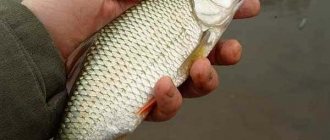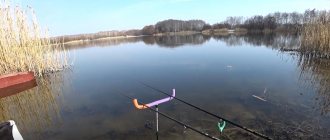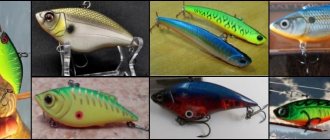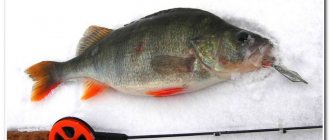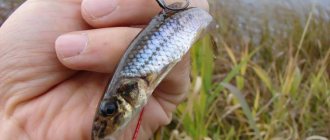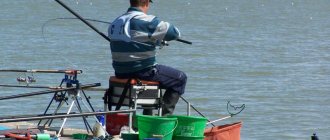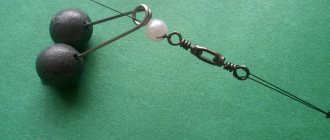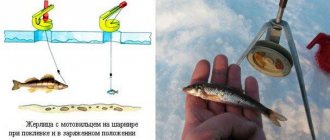Winter fishing for rotan with girders is carried out with the targeted catching of a large predator, from 300 grams and more. Some fishermen practice this type of fishing in winter just for fun, watching the murderous ruthlessness of nature. You catch a 50-gram small rotan, put it on a bait, and a slightly larger firebrand, 70 grams, immediately grabs it. In turn, you put it on the hook, too, and you catch a hundred-gram predator. And so on.
Winter fishing for rotan
For a long time now, winter fishing for rotan has been not just entertainment, but full-fledged fishing, especially in reservoirs where the population of this Far Eastern guest lives for a long time and there are individuals weighing up to a kilogram. The gastronomic qualities of rotan are excellent, but in order to catch it with cutlets, you need to try to find a decent size firebrand. An article about catching large rotan in winter.
If the bite is normal, then the firebrand sits on the hook one by one. This kind of fishing gets boring. Catching rotan on baits in winter is aimed at cutting off small fish and catching larger specimens. Rotan takes no worse on a rod than on a fishing rod. You just need to take into account some nuances associated with the greed of this predator. If you want to catch a firebrand of 100 grams or more, then the bait on the hook of the girder must be appropriate. If there are a large number of small firebrands in the reservoir, the main task in winter is to present the bait so that it has time to wait for a large predator before it is torn apart by the small ones.
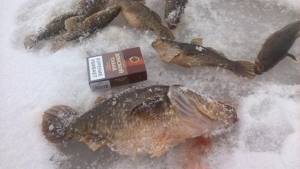
Where to look for rotan in winter
If you are going to catch rotan in an unfamiliar body of water, you should know where to look for this cunning underwater predator. You should immediately prepare for the fact that finding it is not so easy, so when going fishing, carefully examine the surrounding area. This will help determine possible habitats for future catches.
Typically rotans prefer to settle in the following areas:
- Thickets of reeds or bushes located directly near the shore. In such areas, you can find an underwater predator at the beginning of winter, when the first ice has just begun to form (Figure 2).
- Dense weed beds containing small fish or other aquatic life are also considered good fishing spots. Naturally, it is better to identify such areas before the onset of cold weather, when underwater vegetation is clearly visible.
- You can also find predatory fish in cluttered areas of the reservoir, where there are a lot of fallen trees, branches, snags or other debris of natural origin.
- Rotans also like to settle on the border between vegetation and the bare bottom. In addition, the predator can be found in areas located between holes and shallow water, because this is where the bulk of fish prefer to hide.
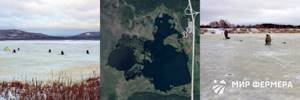
In winter, rotan can be found at the confluence of streams and small rivers, as well as where cold springs gush out from under the water. The thing is that such cold water contains much more oxygen than other parts of the reservoir. If you manage to find such a place, successful fishing for rotan can last all winter. As a rule, these underwater predators prefer to settle near the very bottom, but in some cases they can be caught in shallow water.
Equipment for vents
Rotan is caught using a girder according to all the same canons as with ordinary fishing rods. There’s no need to bother too much with the design – the simplest equipment will do for the firebrand. The fishing depth in winter is usually 0.5-1 meter. Sometimes the entire layer of water is filled with mud and algae, so the equipment must be placed above the thickets.
For most cases, a meter-long piece of fishing line 0.3-0.5, a sliding sinker, a double hook and a crossbar stick (flyer) installed on the hole is enough. The excess fishing line is wound around a stick and secured in the split. The design of the winter stand can be any - the main thing is that it is convenient for the fisherman to maneuver with them.
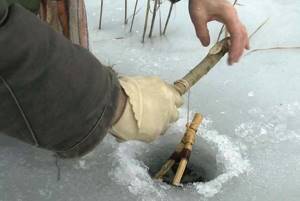
Rotan bites greedily and is not afraid of thick gear, so a metal leash on the bait will not hurt. The rotan will not immediately bite through the fishing line - the teeth are too small. Therefore, when fishing for interest, you don’t have to use a leash, tying the hook directly to the fishing line. However, during long-term intensive fishing, rotan can damage the fishing line over time - in this case, a leash on the girder is not superfluous.
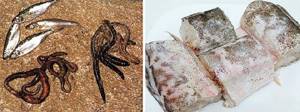
When equipping a bait hook on rotan, it is better to hook live bait with a double through the gills - with such a landing, there are practically no slippages. The predator grabs the bait greedily, bites it and tries to swallow it, even though it is slightly smaller in size than the attacker. When a baitfish is caught on the back, the predator often simply pulls the bait off the bait with impunity.
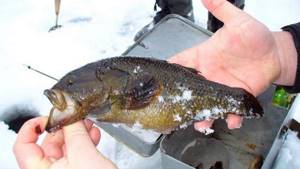
Standard checkboxes
If there are pike and gizzards in the reservoir, serious ones are used. The toothy one, living in the pond with the rotan, does not disdain it, and may well attack such a plant in winter. In such reservoirs, bait stations must be equipped in accordance with all the rules of winter pike rigging. If you climb a little further and deeper, into sparsely populated areas, you can easily find a backwater where giant rotans live, weighing from 500 grams to a kilogram. If a smaller rotan simply sluggishly moves the tackle when biting, then such a one will raise the flag and unwind the fishing line - all according to the laws of the fishing genre. For this kind of fishing, it is better to use serious fishing rods - with flags, reels and a supply of fishing line.

What gear to catch rotan in winter
After selecting a reservoir and identifying promising places, the angler begins fishing. For fishing for rotan in winter, several methods are used, which have their pros and cons:
- winter spinner;
- jig;
- float tackle with a hook;
- float tackle with jig.
Winter spoons are convenient because they allow you to quickly fish large areas, collecting active fish. This gear is suitable for fishing in reservoirs where there is a lot of large rotan. Having caught a certain amount of fish, when the bite dies down, switch to a jig. Small winter spinners up to 30 mm are used, often vertical, since gliders easily collect underwater vegetation. Hooks are equipped with red beads, cambrics or threads. The game should not be very sweeping, with short, infrequent tosses and long pauses. Sometimes miniature balancers are used.
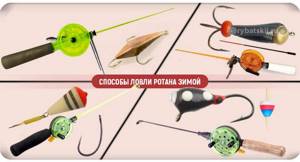
4 options for winter gear for a firebrand
Jig is the most common bait. The most commonly used jigs are silver, golden, red or black. The firebrand is not afraid of large baits and choose a large size for your own convenience. Catching rotan from ice with a jig is perhaps the most convenient option. The shape of the jig does not matter. Rotan responds well to equipping them with various pendants - chains, beads. The mouth of the firebrand is large, so you shouldn’t go too small with the size of the hooks, otherwise there will be a lot of empty hooks and drops in the process; the shank of the hook should be long.
The float fishing rod is equipped with both a hook and a jig. Rotan notices better and more readily attacks bait located in the water column, so the carrying capacity of the float is chosen so that it hangs in the water. A good effect is achieved by periodically playing along with the tackle - if there are no bites for a long time, you can slightly lift the bait, make 2-3 swings and lower it back into place. As a rule, after such manipulations a bite occurs. Float tackle is convenient for stationary fishing, placing several fishing rods close to each other.
Rotan is tolerant of rough equipment. Considering that you often have to fish in overgrown places and often have to pull the bait out of the grass, you don’t have to waste time with the fishing line. For jigs and float rigs, monofilament fishing line with a diameter of 0.12-0.18 is used, for spinners 0.18-0.25 mm. There are no requirements for fishing rods and they choose the one that is convenient for the fisherman. Hard nods are used, since the bite of rotan is most often clear and confident .
Bait for girders
For catching rotan with girders, smaller firebrands are most often used as bait. The cannibalistic predilections of rotan have long been known. And if you hang a 100-gram rattan on a hook, you will catch a 150-gram one. Therefore, to catch decent specimens, you need to use large bait.

It all depends on the characteristics of the reservoir and the time of fishing. In one place, a weighty rotan will be easily caught with a small one, or a piece of it (tail) on a hook. In another, the fish or bait is immediately attacked by small things that are barely able to swallow the bait. In this case, you need to hang a large live bait or a huge piece of lard or chicken skin (100 grams or more) on the hook.
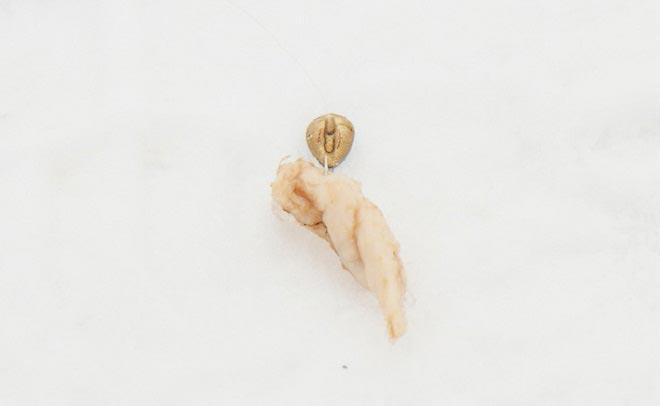
An interesting solution is to place the bait in a bag (minced rotan) made from women's tights - such stray will stay on the hook much longer and, perhaps, will survive until the approach of an adult predator. As bait for rotan, you can use any meat and fish offal, various live bait. But the firebrand works best on rotan, chicken skin or lard.
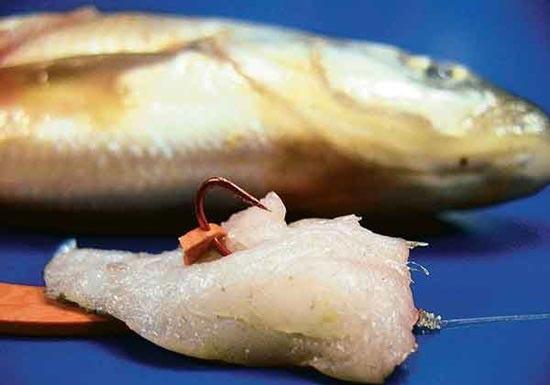
Where did rotan come from in our reservoirs?
Amur sleeper comes from the reservoirs of the middle-lower reaches of the Amur, in fact, from where the silver crucian carp came to us, displacing its golden-red endemic fellow from our reservoirs. But if silver crucian carp was imported in the early fifties of the last century and distributed to pond farms with the purpose of purposefully growing it as food aquaculture, rotan was brought to large cities in Russia already at the beginning of the twentieth century. And the periodic import of this fish to pet stores in the central part of the country from the reservoirs of the Far East as an ornamental aquarium fish continued throughout the first part and the mid-twentieth century.
Apparently, aquarists, having played enough with live rotans, released them into nearby city ponds, where it not only took root well, spawning and producing numerous offspring, but also began a victorious march through other reservoirs of the country.
Now, in the first quarter of the twenty-first century, it is difficult to find small bodies of water within central Russia, and even in many parts with a temperate continental climate in Siberia, where this weed fish is not found.
It does not have any commercial significance, but amateur fishermen often find it a joy, because the concept of lack of bite practically does not apply to rotan.
It bites in those places where it is common, always and almost everywhere. But this is also its disadvantage, many fishermen are already complaining that in certain reservoirs, due to the excessive amount of rotan, it is not possible to wait for other peaceful fish to bite, or the population of this predator is so large that it kills these peaceful fish - crucian carp, tench, roach - I simply ate it.
Read! How to choose a catchable balancer
And so, let’s return directly to the essence of our article - so where and how can you catch large rotan in winter?
Features of tactics
You can catch rotan with girders just for fun, placing a couple of pieces next to the fishing rods. If the goal is to catch as many more normal-sized fish as possible, then the installation of baits needs to be systematized. Such fishing will be laborious, but it will bring a heavier firebrand. In promising places, all the holes are drilled at once, and the flags (bet) are set empty in them one by one. Then we catch small rattans with a fishing rod, a little more in number than the set supply, and equip them. The bets can be equipped with bells - this will make it easier to record a bite in the desired hole amidst the running around. Bait for rotan is not always used, but its use can lure the rotan patriarch out of its writhing.
When it starts to bite, we simply go around all the gear, check it, put larger and larger live bait, until the size limit is revealed. Then we hang live bait on the hook slightly smaller than the size at which there are no longer any bites. This way we will catch only the largest individuals. This tactic requires constant running between the girders and catching live bait with a fishing rod. But it justifies itself - it is important to choose a certain rhythm. Instead of 300 finger-sized fish per cutlet, several dozen 200g are better suited. rotanov.
Subscribe to the channel:
My YouTube channel RYBAFAN on fishing:
We're OK
Behind the firebrand
The big-headed alien from the Far East, which few serious fishermen remember in the summer, suddenly finds itself for some time in the center of attention of the fishing fraternity with the arrival of winter.
Winter fishing for rotan in the Moscow region is usually done when there is first ice. There are several explanations for this. On the one hand, it is possible to get out on the ice first on small, shallow bodies of water protected from the wind. Many of them are inhabited by rotan. When strong ice forms on reservoirs and rivers, the attention of fishermen shifts there.
On the other hand, we most often find significant populations of rotan in small ponds, often with abundant aquatic vegetation; in old overgrown lakes such as Paletsky, Nerskoye; in peat quarries and ditches, channels; in small forest lakes. Life in such reservoirs often stops altogether by the middle of winter.
However, there are flowing ponds and lakes where rotan can be caught with varying success throughout the winter, and very well - on the last ice. A lot here depends on the oxygen regime, the composition of the water, the nature of the bottom, and the availability of food.
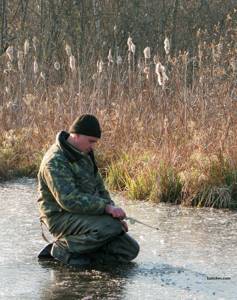
Time
So, the busy time for rotan fishing lovers begins with the very first ice. At this time, if the ground is properly covered with frost, but there is no snow yet, you can make your way by car to the farthest, secluded corners.
Depending on the time of ice formation, weather and characteristics of the reservoir, the period of active biting can last from several days to a couple of weeks. At this time, the chances of catching a particularly large rotan are high, but these big-headed comrades grow up to 500–600 g near Moscow, sometimes even up to a kilogram. That's already something! It is no coincidence that in recent years many fans of this type of fishing have appeared. By the way, knowing a good place, it’s better not to yawn, because rotan is caught quite quickly, “knocked out” even by not particularly experienced fishermen.
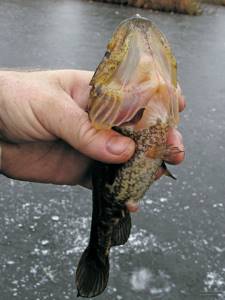
Place
As in open water, rotan is very fond of aquatic vegetation on first ice. It can be soft vegetation, reeds or reeds - it all depends on the reservoir. Therefore, I drill holes first of all at the border of the thickets, in the windows among them.
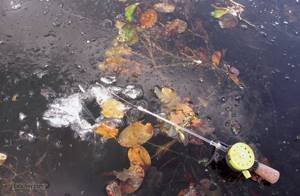
The more “grass” the better. Sometimes you climb into the reeds, drill a hole among the stems, and you’ll end up right on a rotan.
It is also worth paying attention to snags and flooded bushes at shallow depths, especially if there is also grass next to them. All these places can be located either near the shore or in the middle of the reservoir, if it is shallow.
As the ice thickens, rotan usually moves to depth. If bottom irregularities are known, then you should look for it near them, but if they are unknown or absent altogether, which often happens in reservoirs of this type, then you just need to drill holes and check them.
Tactics
In general, when fishing spots are unknown, you must first drill as many holes as possible, since rotan is not particularly shy and is almost not afraid of noise. If there are no bites, then you shouldn’t spend too long on one hole; it’s better to move on to the next one. The slow and phlegmatic rotan is not particularly inclined to move and simply will not approach your bait from afar. Considering this property and the specifics of fishing in the grass, it is not difficult to understand why sometimes rotan is caught in one hole, but in another, some half a meter from the first, there is not a bite.
Often rotan forms small schools, so that it is possible to pull out several fish in a row, sometimes up to a dozen or more.
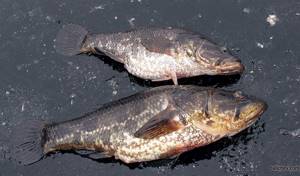
Tackle
It is very popular in our area to catch rotan using small winter lures, adding a piece of meat (beef), less often a piece of fish (including the rotan itself), lard, or a worm. Lard and worms are often placed on a large jig, not much smaller in size than a spinner. If the bite is bad, especially closer to the middle of winter, smaller jigs with pieces of worms, maggots, and bloodworms are also used. In such conditions, bloodworm bait may also be indicated. Rotan can also be caught with all these baits using a simple float rod with a regular hook. In some cases, small, slow-type balancers work well.
The game is recommended to be smooth, with a leisurely rise and long pauses; baits are light, due to the shallow depth (wide, short spoons, jigs made of light materials). Bites can be both sharp, confident, and weak, expressed in a trembling nod. A nod, of course, is required.
In the rotan's mouth there is a real sharp grater made of small teeth. You can scratch your fingers on them, and it swallows deeply, so it is recommended to have with you some kind of tool for removing a hook, jig, spinner (arterial clamp, special extractor...). Sometimes rotan even grinds the fishing line with its teeth, so, regardless of the type of bait, it should not be too thin; In any case, I wouldn’t recommend using “sports” fishing lines. In addition, snagging on the grass is not uncommon. And if a specimen hits half a kilo, it’s not so easy to pull it out even without grass.
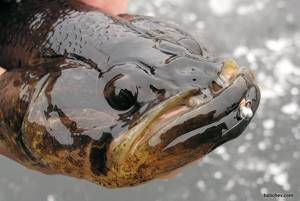
For fry
Separately, I would like to dwell on catching rotan with fry. If the temperature is above zero or near zero, then it is very interesting to fish with a float on the top. Everything is the same as in summer, only the fishing rod is winter and the float floats in the hole. There is a sinker on the line, a hook with a fry. When bitten, the float goes under water.
I remember once I had a good time catching rotan from the ice using imported fry. By noon, the fry began to run out, and I had to cut the fish in half. The bite got worse at first, but immediately recovered as soon as I started twitching the bait. There were rotans up to 300 g.
Or here’s another case: one day in the fall, one of my acquaintances drove past an unfrozen puddle and noticed that there were some strange ripples on the surface of the water in it. Stopped to find out what was what. It turned out that small, small crucian carp, about three centimeters each, had gathered in the puddle. As a result, he caught about one hundred and fifty fish with the lift, with which we then went to the same pond for rotan. It worked great.
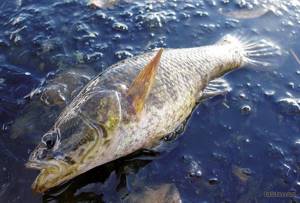
Zherlitsy
I saw one fisherman have special small jigs for rotan. Low tripods, sensitive springs, small flags. The fishing line is 0.20 mm, it has a small sinker, a single hook, preferably with a long shank. Similar girders are made for perch, if anyone has seen them.
The fisherman caught carp, but not as microscopic as ours in the case described above, but up to thirty grams. Here sometimes you come across a very large rotan. Fishing takes place in motion: drilling holes, rearranging the traps, pulling out prey, etc. You can load the zherlitsa with verkhovka, but then you also come across small rotan.
It happens that a large rotan is tempted by live bait on a pike bait, and if such cases are rare, it is only because there are not many reservoirs where there is a lot of sleeper and where, at the same time, pike are caught with winter baits.
Author: Petr Skuratov Photo by the author
This article by Pyotr Yuryevich Skuratov was published in “Fishing Journal” No. 1/08. Reproduced from the editorial archive.
